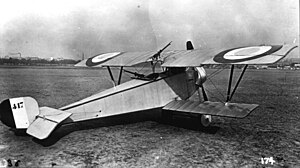| Nieuport 12 | |
|---|---|
| Nieuport 12 A.2 prototype | |
| Role | Reconnaissance(Artillery)/Fighter/Trainer |
| Manufacturer | Nieuport |
| Designer | Gustave Delage |
| Primary users | France Russian Empire United Kingdom |
| Developed from | Nieuport 10 |
The Nieuport 12 was a French biplane reconnaissance, fighter aircraft and trainer used by France, Russia, Great Britain and the United States during World War I. Later production examples were built as trainers and served widely until the late 1920's.
Design and development[]
To improve the performance of the Nieuport 10 a larger and re-engined version was developed as the Nieuport 12. A Lewis gun was fitted to the rear cockpit for use of the observer, normally on a Nieuport ring. A second Lewis was sometimes fitted to fire over the top wing. Nieuport 12s built by Beardmore used by the Royal Flying Corps were often fitted with a Scarff ring instead of the Nieuport ring, and a synchronized Vickers gun for the pilot. Additional modifications were made to those built by Beardmore.
It could be fitted with either a 100 hp (82 kW) or 130 hp (97 kW) Clerget engine or 110 hp (82 kW) Le Rhône 9J mounted in the nose.
Variants[]
- Nieuport 12 A.2
- Two-seat fighter-reconnaissance biplane, powered by 110 hp (82 kW) Clerget 9Z engine.[1] or 110 hp (82 kW) Le Rhône 9J.
- Nieuport 12bis C.2
- Revised version with 130 hp (97 kW) Clerget 9C engine and streamlined side fairings.[2]
- Nieuport 13
- 2 prototypes with increased span but same nominal wing area as 12. One powered by a 140 hp (100 kW) Hispano Suiza, and the other by an 80 hp (60 kW) Le Rhône 9C.
- Nieuport 20
- Version powered by 110 hp (82 kW) Le Rhône 9J. Not used by France, but 21 delivered to Royal Flying Corps.[3] All but first examples externally similar to 12bis.
- 23 Meter Nieuport
- Unofficial generic designation for all types listed here based on nominal wing area of 23 square meters.
- Nieuport 80 E.2 and 81 E.2
- Nieuport 12s were later built in large numbers specifically as training aircraft with the gun ring removed. 8 in designation referred to 80 hp (60 kW) Le Rhône 9C. These differed in having flight controls for just the pilot in the rear seat (81 E.2), or both pilot and passenger (80 E.2).
- Nieuport 12 (Beardmore)
- Beardmore extensively redesigned the Nieuport 12 during production so early examples were stock but late production examples differed considerably in detail. Only the 110 and 130 hp Clerget rotaries were used on these.
- Mitsubishi Army Type Ko 1 Trainer
- Japanese designation for licence built Nieuport 81 E.2s. 57 built.[4]
- Trainer Type 1
- Siamese designation for Nieuport 80 E.2.
- Sipowicz 1
- Polish experimental aircraft using lifting struts similar to the Wright-Bellanca WB-2.
Operators[]
- Estonian Air Force - Postwar.
- Imperial Japanese Army Air Service - received 40 Nieuport 81 E.2 from France in 1919, supplementing them by 57 licence-built aircraft.[4]
- Royal Thai Air Force - One aircraft only.
- Royal Flying Corps
- Royal Naval Air Service
- No. 7 Squadron RNAS
- No. 10 Squadron RNAS
Soviet Union
- Workers' and Peasants' Air Fleet
Survivor[]
A single ex-French Nieuport 12 is on display following an extensive restoration (including re-installing the original Le Rhône 9J rotary engine) at the Canada Aviation and Space Museum in Ottawa. This aircraft was donated to the Canadian Dominion Archive along with a Canon de 75 modèle 1897 cannon and an extensive collection of propaganda posters by the French Government in 1916 and was used for war bond drives until the 1918 flu pandemic resulted in it being placed in storage until the Royal Canadian Air Force tried to convert it into an RFC example for display.
Specifications (110 hp Clerget engine)[]
Data from The Complete Book of Fighters[5]
General characteristics
- Crew: 2 (pilot, observer)
- Length: 7.00 m (22 ft 11½ in)
- Wingspan: 9.00 m (29 ft 6 in)
- Wing area: 22.0 m2 (237 ft2)
- Empty weight: 550 kg (1,213 lb)
- Gross weight: 850 kg (1,874 lb)
- Powerplant: 1 × Clerget, 82 kW (110 hp)
Performance
Armament
See also[]
- Nieuport 10
- List of military aircraft of France
- List of aircraft of the Royal Flying Corps
- List of aircraft of the Royal Naval Air Service
- List of fighter aircraft
References[]
| Wikimedia Commons has media related to Nieuport 12. |
Notes[]
Bibliography[]
- The Illustrated Encyclopedia of Aircraft (Part Work 1982-1985). Orbis Publishing. pp. 2597.
- Bruce, J.M. (1988). Nieuport Aircraft of World War One - Vintage Warbirds No 10. London: Arms and Armour Press. ISBN 0-85368-934-2.
- Bruce, J.M. (1998). Nieuport 10~12 - Windsock Datafile 68. Herts: Albratros Publications. ISBN 1-902207-01-7.
- Bruce, J.M. (1982). The Aeroplanes of the Royal Flying Corps (Military Wing). London: Putnam. ISBN 0-370-30084-X.
- Green, W; Swanborough, G (1994). The Complete Book of Fighters. Smithmark. ISBN 0-8317-3939-8.
- Mikesh, Robert C.; Abe, Shorzoe (1990). Japanese Aircraft 1910–1941. London: Putnam Aeronautical Books. ISBN 0-85177-840-2.
- Sanger, Ray (2002). Nieuport Aircraft of World War One. Wiltshire: Crowood Press. ISBN 1-86126-447-X.
- Thetford, Owen (1978). British Naval Aircraft since 1912 (Fourth Edition ed.). London: Putnam. ISBN 0-85177-861-5.
The original article can be found at Nieuport 12 and the edit history here.
